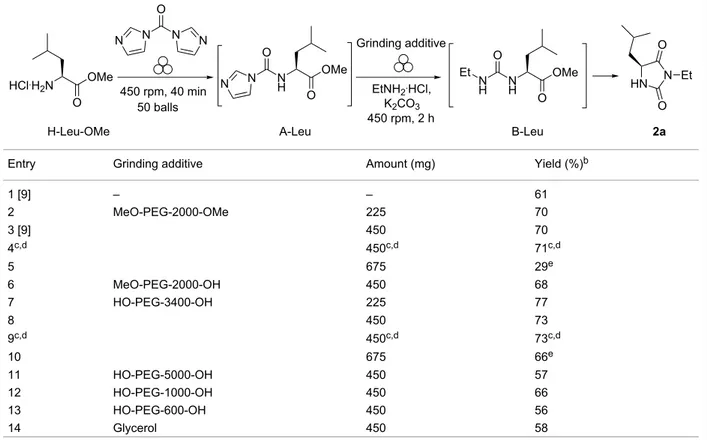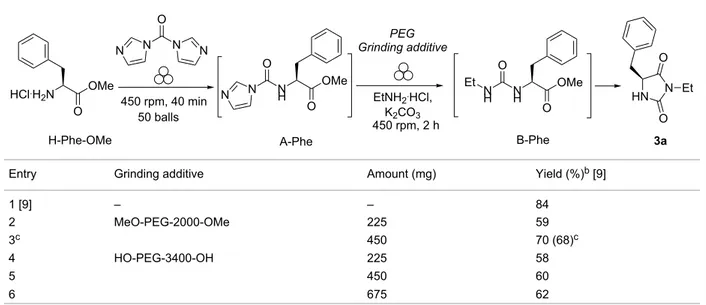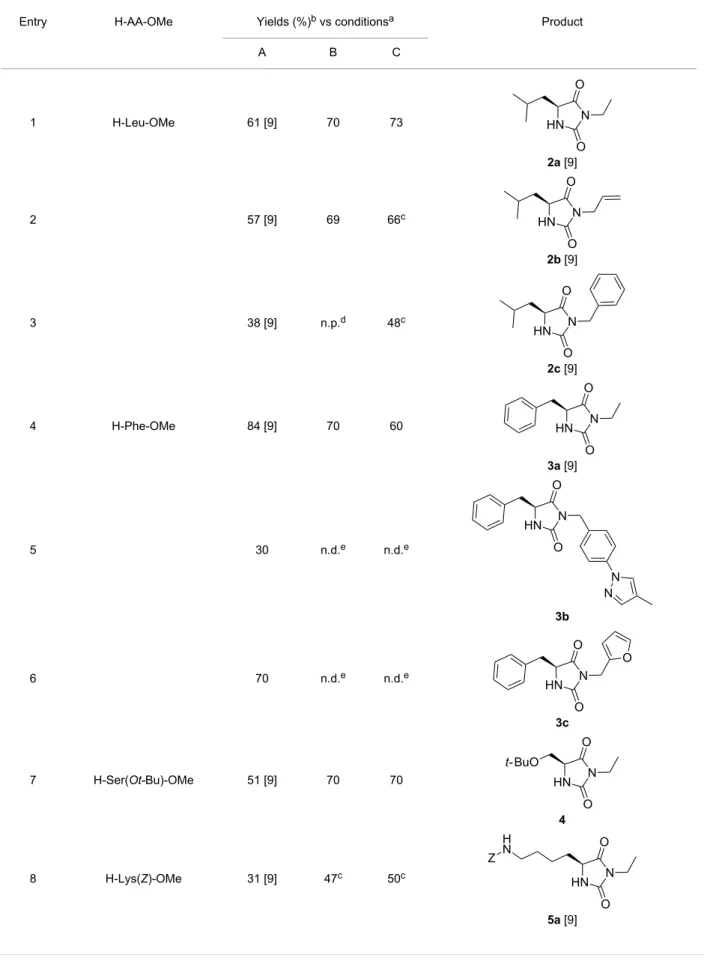mechanochemical preparation of highly functionalized
3,5-disubstituted hydantoins
Andrea Mascitti
‡1,2, Massimiliano Lupacchini
‡1,2, Ruben Guerra
2, Ilya Taydakov
3,4,
Lucia Tonucci
5, Nicola d’Alessandro
1, Frederic Lamaty
2, Jean Martinez
2and Evelina Colacino
*2Full Research Paper
Open AccessAddress:
1Department of Engineering and Geology (INGEO), G.d’Annunzio University of Chieti-Pescara, Via dei Vestini, 31, 66100 Chieti Scalo, Italy, 2Université de Montpellier, Institut des Biomolécules Max Mousseron (IBMM), UMR 5247 CNRS - UM - ENSCM, Place E. Bataillon, Campus Triolet, 34095 Montpellier CEDEX 5, France, 3P.N. Lebedev Institute of Physics of RAS, Leninskiy pr-t, 53, 119991, Moscow, Russia, 4Moscow Institute of Physics and Technology, Institutskiy per., 9, 141700, Dolgoprudny, Russia and 5Department of Philosophical, Educational and Economic Sciences, G. d’Annunzio University of Chieti-Pescara, Via dei Vestini, 31, 66100 Chieti Scalo, Italy
Email:
Evelina Colacino* - [email protected] * Corresponding author ‡ Equal contributors
Keywords:
ball-milling; 1,1’-carbonyldiimidazole (CDI); hydantoins; mechanochemistry; liquid-assisted grinding (LAG); poly(ethylene) glycols (PEGs)
Beilstein J. Org. Chem. 2017, 13, 19–25.
doi:10.3762/bjoc.13.3
Received: 01 October 2016 Accepted: 12 December 2016 Published: 04 January 2017
This article is part of the Thematic Series "Green chemistry".
Guest Editor: L. Vaccaro
© 2017 Mascitti et al.; licensee Beilstein-Institut. License and terms: see end of document.
Abstract
The mechanochemical preparation of highly functionalized 3,5-disubstituted hydantoins was investigated in the presence of various poly(ethylene) glycols (PEGs), as safe grinding assisting agents (liquid-assisted grinding, LAG). A comparative study under dry-grinding conditions was also performed. The results showed that the cyclization reaction was influenced by the amount of the PEG grinding agents. In general, cleaner reaction profiles were observed in the presence of PEGs, compared to dry-grinding procedures.
Introduction
Poly(ethylene) glycols (PEGs) are eco-friendly solvents [1,2], finding applications in the biomedical field and for pharmaceu-tical formulations [3] and catalysis [4]. PEG-based reaction
media [1] are safe reaction environments, efficiently heated by microwaves [5], but their use in organic transformations acti-vated by other alternative energy inputs is still scarce. Only
Scheme 1: PEG-assisted grinding strategy for the preparation of 3,5-disubstituted hydantoins. three examples highlight their peculiar role for metal-catalysed
processes in a ball mill (Mirozoki–Heck reaction) [6], by ultra-sound (copper-catalysed cyanation reaction) [7], and for co-crystal formation in the polymer-assisted grinding process (POLAG) [8]. However, to the best of our knowledge, the systematic investigation of the influence of PEG polymers has not been reported yet for organic syntheses promoted by me-chanical energy.
We firstly reported the positive influence of PEG solvents as grinding agents for the mechanochemical preparation of an active pharmaceutical ingredient (API), the anticonvulsant drug ethotoin 7 [9] (marketed as Peganone®, Scheme 1). We describe herein the impact of the addition of variable amounts of PEG, PEG chain length and end terminal groups, for the preparation of diverse 3,5-disubstituted hydantoins from α-amino methyl esters 1, via an in situ intramolecular cycliza-tion reaccycliza-tion of the ureido derivative B, which was obtained from N-carbamoylimidazole activated amino ester derivative A by reaction with various amines [9-11] (Scheme 1). Hanusa’s formalism was used to represent the reaction activated by mechanochemical energy [12].
The yields, reaction rates and chemoselectivity obtained in the presence of melted PEGs were compared with the results ob-tained in dry-grinding conditions.
Results and Discussion
H-Leu-OMe was used as benchmark for the mechanochemical preparation of 3-ethyl-5-isobutylhydantoin (2a) (R1 = CH2CH(CH3)2 and R2 = CH2CH3, Scheme 1) [9]. The reaction was screened in the presence of various PEG additives (Table 1), by adding variable amounts of PEGs, with different molecular weights (600 < Mw < 5000 Dalton) or chain end groups (dihydroxy, mono- or dimethyl ether substituents) in the second step (Table 1). The first set of experiments was aimed to determine if the addition of variable amounts of solid MeO-PEG-2000-OMe (Table 1, entries 2–5) or HO-PEG-3400-OH (Table 1, entries 7–10) could impact both the reaction yield and rate, compared to dry-grinding conditions previously reported [9] (Table 1, entry 1). Yields were generally improved in the presence of variable amounts of PEGs (Table 1, entries 2, 3 and 7, 8), starting to decrease when reaching a critical value at 675 mg (Table 1, entries 5 and 10). The substrate conversion remained moderate, the cyclization reaction of the correspond-ing ureido derivative B-Leu was slowed down and the methyl ester moiety was partially hydrolysed. Indeed, the base activity was increased due to the presence of water in PEG as well as by the PEG crown-ether-like effect [1], chelating the potassium cations.
It is worth noticing here that the crude mixture was cleaner in comparison with dry-grinding conditions. Indeed, the
symmetri-Table 1: Screening of grinding additives using (L)-H-Leu-OMe.HCl as benchmark for the preparation of compound 2a.a
Entry Grinding additive Amount (mg) Yield (%)b
1 [9] – – 61 2 MeO-PEG-2000-OMe 225 70 3 [9] 450 70 4c,d 450c,d 71c,d 5 675 29e 6 MeO-PEG-2000-OH 450 68 7 HO-PEG-3400-OH 225 77 8 450 73 9c,d 450c,d 73c,d 10 675 66e 11 HO-PEG-5000-OH 450 57 12 HO-PEG-1000-OH 450 66 13 HO-PEG-600-OH 450 56 14 Glycerol 450 58
aConditions: (step 1) (L)-H-Leu-OMe.HCl (1 mmol) and CDI (1.3 equiv.) at 450 rpm, in a planetary ball mill (PBM) using a 12 mL SS jar with 50 balls (SS = stainless steel, 5 mm Ø) for 40 min; (step 2) EtNH2.HCl (1.6 equiv), K2CO3 (3.6 equiv) and the grinding additive RO-PEGn-OR (R = H, Me, n = 14, 23, 46, 77, 114) or glycerol (450 mg mmol−1) (see Supporting Information File 1 for experimental details); bIsolated yields; cThe reaction time in the second step was 3 h; dPEG was precipitated in diethyl ether, then filtered and dried in the air before use [16]; e1H NMR yield.
cal urea of the starting amino ester – obtained from the corre-sponding N-carbamoyl imidazole amino ester A – was not ob-served, as shown by the LC–MS analyses of the crude mixture. An approach complementing similar strategies was already de-scribed to avoid the formation of symmetrical ureas in solution [13].
The preparation of the hydantoin 2a was also investigated using batches of solid PEGs (Mw = 2000 and 3400) in which PEGs with lower molecular weight (Mw = 200–400) were eliminated before use by a precipitation/filtration procedure (Table 1, entries 4 and 9), according to a well-established protocol [14-16]. Even when the PEG polymers were supposed to be homo-geneously liquids (melting point around 55 °C) at the opera-tional temperature, comparable yields could be obtained only by extending the reaction time (3 h instead of 2 h), when ‘pre-treated’ PEGs were used instead of ‘unfiltered’ PEGs (Table 1, entries 3 and 8).
This observation suggested that changes in the ‘physical state of the system could be induced by specific interactions with PEG polymers and influenced both by the viscosity and the polymer
chain length. After selecting the optimal polymer amount (450 mg mmol−1), the study was carried on by increasing (Table 1, entry 11) or reducing (Table 1, entries 12 and 13) the polymer chain length, changing the end terminal substitu-ents (Table 1, entries 6 vs 3), and adding glycerol instead of PEGs as additive (Table 1, entry 14). As a result, the effect of using different end terminal groups was not markedly signifi-cant, the yield was a function of the average molecular weight of the PEG used: HO-PEG-5000-OH (Table 1, entry 11) was probably too viscous to allow the diffusion of reactants. De-creased and comparable yields were also observed by reducing the PEG chain length (Table 1, entry 13) and by using glycerol. It is also worth noting here that not only viscosity, but any mod-ification of the physical state of the system impacted the outcome of the reaction. Indeed, HO-PEG-600-OH (0.119 cSt) led to comparable yields when replaced by a more viscous liquid like glycerol (1.12 cSt) (Table 1, entry 14), an eco-friendly solvent still not investigated for liquid-assisted grinding procedures. In fact such a compound is becoming a green source of several building blocks since glycerol is actually pro-duced in very large amount as byproduct from biodiesel synthe-sis [17].
Table 2: Optimization of liquid-assisted grinding conditions using (L)-H-Phe-OMe.HCl as benchmark for the preparation of compound 3a.a
Entry Grinding additive Amount (mg) Yield (%)b [9]
1 [9] – – 84 2 MeO-PEG-2000-OMe 225 59 3c 450 70 (68)c 4 HO-PEG-3400-OH 225 58 5 450 60 6 675 62
aConditions: (step 1) (L)-H-Phe-OMe.HCl (1 mmol) and CDI (1.3 equiv) at 450 rpm, in a planetary ball-mill (PBM) using a 12 mL SS jar with 50 balls (SS = stainless steel, 5 mm Ø) for 40 min; (step 2) EtNH2.HCl (1.6 equiv), K2CO3 (3.6 equiv) and RO-PEGn-OR (R = H, Me, n = 46, 77) (see Support-ing Information File 1 for experimental details); bisolated yields; cD-H-Phe-OMe was used.
With this background, 3-ethyl-5-benzylhydantoin (3a) [9] (R1 = CH2Ph and R2 = CH2CH3) was also prepared using solid MeO-PEG-2000-OMe and HO-PEG-3400-OH as additives (Table 2). Using (L)-H-Phe-OMe.HCl as substrate, as a general trend and in comparison with the dry-grinding procedure previ-ously reported [9] (Table 2, entry 1), yields were generally lower with PEG additives, independently on their size and amounts (Table 2). This trend, apparently in contrast with the results illustrated so far for 3-ethyl-5-isobutylhydantoin (2a) [9] suggested that the reactivity of the system might be also a func-tion of the nature of the amino ester side chain, influencing the solubility of the reactants, reaction intermediates and final prod-ucts. However, no differences in yields were observed when (D)-H-Phe-OMe was used, instead of its enantiomer (Table 2, entry 3).
Therefore, the one-pot two-steps cyclization reaction was inves-tigated with different amino ester/amine combinations (H-AA-OMe/R2-NH2) and comparative experiments using dry- or wet-grinding with PEGs (Mw = 2000 and 3400, 450 mg mmol−1) were also performed (Table 3).
Indeed, compounds with the same N-R2 substituent led to vari-able yields for different amino esters (R1, Scheme 1 and Table 3), as shown for experiments performed in both dry-grinding conditions in the series 3b and 5b (R2 = 1-[4-(4-methyl-1H-pyrazol-1-yl)phenyl]methyl, Table 3, entries 5 and 9), 3c and 5c (R2 = furan-1-ylmethyl, Table 3, entries 6 and 10), and wet-grinding experiments with PEGs, for the series 2a, 3a,
4 (Table 3, entries 1, 4, and 7, respectively) and 5a (R2 = ethyl, Table 3, entry 8) or 2b and 6 (R2 = allyl , Table 3, entries 2 and 12). However, the PEG influence on the reaction yield could not be excluded. The mechanochemical productivity was slightly improved when PEG polymers were used compared to dry-grinding conditions, as demonstrated for the synthesis of hydan-toins 2a–c (Table 3, entries 1–3), 5a (Table 3, entry 8) and 6 (Table 3, entry 12), with the exception of hydantoins 3a (Table 3, entry 4) and 5b (Table 3, entry 9). Moreover, the prep-aration of hydantoins 3b and 3c (Table 3, entries 5 and 6) in the presence of PEG led to incomplete conversion of starting mate-rials, together with the formation of various unknown byprod-ucts. A possible explanation can be related to the solubility of reactants, reaction intermediates and final products in PEG polymers, although the existence of specific interactions with PEG polymers cannot be excluded. Indeed, especially under mechanical stress, PEGs are known to induce changes in the physical state of the system [8].
These results confirmed the role played by polymers in mechanochemical transformations, also leading to cleaner reac-tion profiles. However, the choice of the suitable polymer for a specific transformation was not trivial: the ‘fine tuning’ of the physical state of the system was also related to specific physi-cal aspects also connected to the intrinsic properties of the polymer. In addition, PEG polymers were demonstrated as a valid eco-friendly and safe alternative to classic solvents used in liquid-assisted-grinding procedures (LAG) [18-22] due to their low melting point (45–60 °C), enabling their use as melt during
Table 3: Syntheses of 3,5-disubstituted hydantoins under dry-grinding (conditions A)a or PEG-assisted grinding (conditions B and C).b
Entry H-AA-OMe Yields (%)b vs conditionsa Product
A B C 1 H-Leu-OMe 61 [9] 70 73 2a [9] 2 57 [9] 69 66c 2b [9] 3 38 [9] n.p.d 48c 2c [9] 4 H-Phe-OMe 84 [9] 70 60 3a [9] 5 30 n.d.e n.d.e 3b 6 70 n.d.e n.d.e 3c 7 H-Ser(Ot-Bu)-OMe 51 [9] 70 70 4 8 H-Lys(Z)-OMe 31 [9] 47c 50c 5a [9]
Table 3: Syntheses of 3,5-disubstituted hydantoins under dry-grinding (conditions A)a or PEG-assisted grinding (conditions B and C).b (continued) 9 62 n.p.d 37c 5b 10 37 n.p.d n.p.d 5c 11 47 n.p.d n.p.d 5d 12 H-Aib-OMe 46 [9] 62 62 6 [9]
aConditions: (step 1) (L)-α-amino ester hydrochloride (1 equiv) and CDI (1.3 equiv) at 450 rpm, in a 12 mL inox jar with 50 balls (stainless steel, 5 mm Ø) for 40 min; (step 2) R2NH2 (1.6 equiv) and K2CO3 (3.6 equiv) at 450 rpm for 2 hours. A: the reaction was performed with no additive (dry-grinding); B: MeO-PEG-2000-OMe (450 mg mmol−1); C: HO-PEG-3400-OH (450 mg mmol−1) were added in the second step (wet-grinding conditions with a PEG additive; bisolated yields; c1H NMR yield on the crude reaction mixture; dthe reaction was not performed (n.p.); ethe reaction yield was not deter-mined (n.d.).
grinding, low toxicity and low vapour pressure, reducing the risk of explosions or overpressure that might be encountered on large scale LAG-procedures.
Supporting Information
Supporting Information File 1
Experimental procedures, characterization of new compounds and copies of 1H and 13C NMR spectra. [http://www.beilstein-journals.org/bjoc/content/ supplementary/1860-5397-13-3-S1.pdf]
Acknowledgements
The authors acknowledge the MIUR for the grants to A.M. and M.L. (Fondo Sostegno Giovani – FSG – 2012 and 2013). I.T. is grateful to Russian Scientific Foundation (grant 15-19-00205) for partial financial support of this work.
References
1. Chen, J.; Spear, S. K.; Huddleston, J. G.; Rogers, R. D. Green Chem. 2005, 7, 64–82. doi:10.1039/b413546f
2. Prat, D.; Wells, A.; Hayler, J.; Sneddon, H.; McElroy, C. R.; Abou-Shehada, S.; Dunn, P. J. Green Chem. 2016, 18, 288–296. doi:10.1039/C5GC01008J
3. Knop, K.; Hoogenboom, R.; Fischer, D.; Schubert, U. S.
Angew. Chem., Int. Ed. 2010, 49, 6288–6308.
doi:10.1002/anie.200902672
4. Colacino, E.; Martinez, J.; Lamaty, F.; Patrikeeva, L. S.; Khemchyan, L. L.; Ananikov, V. P.; Beletskaya, I. P.
Coord. Chem. Rev. 2012, 256, 2893–2920.
doi:10.1016/j.ccr.2012.05.027
5. Kappe, C. O. Angew. Chem., Int. Ed. 2004, 43, 6250–6284. doi:10.1002/anie.200400655
6. Declerck, V.; Colacino, E.; Bantreil, X.; Martinez, J.; Lamaty, F.
Chem. Commun. 2012, 48, 11778–11780. doi:10.1039/c2cc36286d
7. Giachi, G.; Frediani, M.; Oberhauser, W.; Lamaty, F.; Martinez, J.; Colacino, E. ChemSusChem 2014, 7, 919–924.
8. Hasa, D.; Schneider Rauber, G.; Voinovich, D.; Jones, W.
Angew. Chem., Int. Ed. 2015, 54, 7371–7375.
doi:10.1002/anie.201501638
9. Konnert, L.; Dimassi, M.; Gonnet, L.; Lamaty, F.; Martinez, J.; Colacino, E. RSC Adv. 2016, 6, 36978–36986.
doi:10.1039/C6RA03222B
10. Konnert, L.; Gonnet, L.; Halasz, I.; Suppo, J.-S.;
Marcia de Figueiredo, R.; Campagne, J.-M.; Lamaty, F.; Martinez, J.; Colacino, E. J. Org. Chem. 2016, 81, 9802–9809.
doi:10.1021/acs.joc.6b01832
11. Konnert, L.; Gonnet, L.; Halasz, I.; Suppo, J. S.;
Marcia de Figueiredo, R.; Campagne, J.-M.; Lamaty, F.; Martinez, J.; Colacino, E. J. Org. Chem. 2016, 81, 12071.
doi:10.1021/acs.joc.6b02671
12. Rightmire, N. R.; Hanusa, T. P. Dalton Trans. 2016, 45, 2352–2362. doi:10.1039/C5DT03866A
The formalism for mechanochemically activated reactions was recently proposed by this group.
13. Duspara, P. A.; Islam, M. S.; Lough, A. J.; Batey, R. A. J. Org. Chem. 2012, 77, 10362–10368. doi:10.1021/jo302084a
14. Colacino, E.; Daïch, L.; Martinez, J.; Lamaty, F. Synlett 2007, 1279–1283. doi:10.1055/s-2007-980337
15. Colacino, E.; Villebrun, L.; Martinez, J.; Lamaty, F. Tetrahedron 2010,
66, 3730–3735. doi:10.1016/j.tet.2010.03.065
16. Bailey, F. E. J.; Koleske, J. V. Poly(Ethylene Oxide); Academic Press: New York, 1976.
17. Canale, V.; Tonucci, L.; Bressan, M.; d'Alessandro, N.
Catal. Sci. Technol. 2014, 4, 3697–3704. doi:10.1039/C4CY00631C
18. Friščić, T. J. Mater. Chem. 2010, 20, 7599–7605. doi:10.1039/c0jm00872a
19. Friščić, T. Chem. Soc. Rev. 2012, 41, 3493–3510. doi:10.1039/c2cs15332g
20. Shimono, K.; Kadota, K.; Tozuka, Y.; Shimosaka, A.; Shirakawa, Y.; Hidaka, J. Eur. J. Pharm. Sci. 2015, 76, 217–224.
doi:10.1016/j.ejps.2015.05.017
21. Juribašić, M.; Halasz, I.; Babić, D.; Cinčić, D.; Plavec, J.; Ćurić, M.
Organometallics 2014, 33, 1227–1234. doi:10.1021/om500008v
22. Chen, L.; Regan, M.; Mack, J. ACS Catal. 2016, 6, 868–872. doi:10.1021/acscatal.5b02001
License and Terms
This is an Open Access article under the terms of the Creative Commons Attribution License
(http://creativecommons.org/licenses/by/4.0), which permits unrestricted use, distribution, and reproduction in any medium, provided the original work is properly cited. The license is subject to the Beilstein Journal of Organic Chemistry terms and conditions:
(http://www.beilstein-journals.org/bjoc)
The definitive version of this article is the electronic one which can be found at:



